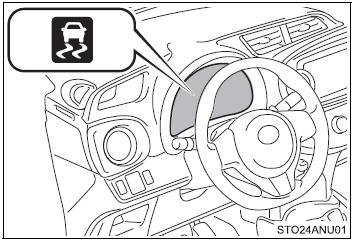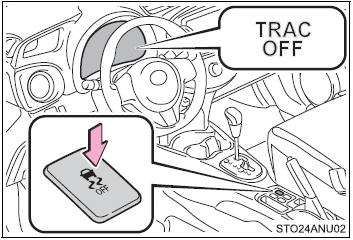 Toyota Yaris: Driving assist systems
Toyota Yaris: Driving assist systems
To help enhance driving safety and performance, the following systems operate automatically in response to various driving situations. Be aware, however, that these systems are supplementary and should not be relied upon too heavily when operating the vehicle.
■ ABS (Anti-lock Brake System)
Helps to prevent wheel lock when the brakes are applied suddenly, or if the brakes are applied while driving on a slippery road surface.
■ Brake assist
Generates an increased level of braking force after the brake pedal is depressed when the system detects a panic stop situation.
■ VSC (Vehicle Stability Control)
Helps the driver to control skidding when swerving suddenly or turning on slippery road surfaces.
■ TRAC (Traction Control)
Helps to maintain drive power and prevent the drive wheels from spinning when starting the vehicle or accelerating on slippery roads.
■ EPS (Electric Power Steering)
Employs an electric motor to reduce the amount of effort needed to turn the steering wheel.
When the TRAC/VSC systems are operating

The slip indicator light flashes to indicate that the TRAC/VSC systems have been engaged.
Disabling the TRAC/VSC systems
If the vehicle gets stuck in fresh snow or mud, TRAC/VSC systems may reduce power from the engine to the wheels. You may need to turn the system off to enable you to rock the vehicle in order to free it.
■ Turning off the TRAC system only

To turn the TRAC system off, quickly press and release the button. The “TRAC OFF” indicator light will come on. Press the button again to turn the system back on.
■ Turning off both TRAC and VSC systems

To turn the TRAC and VSC systems off, press and hold the button for more than 3 seconds while the vehicle is stopped. The “TRAC OFF” indicator light and VSC OFF indicator light will come on. Press the button again to turn the systems back on.
■When the “TRAC OFF” indicator light comes on even if the VSC OFF switch has not been pressed
TRAC system cannot be operated. Contact your Toyota dealer.
■Sounds and vibrations caused by the ABS, brake assist, VSC and TRAC
●A sound may be heard from the engine compartment when the engine is started
or just after the vehicle begins to move. This sound does not indicate that a malfunction
has occurred in any of these systems.
●Any of the following conditions may occur when the above systems are operating.
None of these indicates that a malfunction has occurred.
• Vibrations may be felt through the vehicle body and steering.
• A motor sound may be heard after the vehicle comes to a stop.
• The brake pedal may pulsate slightly after the ABS is activated.
• The brake pedal may move down slightly after the ABS is activated.
■EPS operation sound
When the steering wheel is operated, a motor sound (whirring sound) may be heard. This does not indicate a malfunction.
■Reactivation of the TRAC/VSC systems after turning off the engine
Turning off the engine after turning off the TRAC/VSC systems will automatically reactivate them.
■Reactivation of the TRAC system linked to vehicle speed
When only the TRAC system is turned off, the TRAC system will turn on when vehicle speed increases. However, when both TRAC and VSC systems are turned off, the systems will not turn on even when vehicle speed increases.
■Reduced effectiveness of the EPS system
The effectiveness of the EPS system is reduced to prevent the system from overheating when there is frequent steering input over an extended period of time. The steering wheel may feel heavy as a result. Should this occur, refrain from excessive steering input or stop the vehicle and turn the engine off. The EPS system should return to normal within 10 minutes.
■If the slip indicator comes on...
It may indicate a malfunction in the driving assist systems. Contact your Toyota dealer.
CAUTION
■The ABS does not operate effectively when
●The limits of tire gripping performance have been exceeded (such as excessively
worn tires on a snow covered road).
●The vehicle hydroplanes while driving at high speed on the wet or slick roads.
■Stopping distance when the ABS is operating may exceed that of normal conditions
The ABS is not designed to shorten the vehicle’s stopping distance. Always maintain a safe distance from the vehicle in front of you, especially in the following situations:
●When driving on dirt, gravel or snow-covered roads
●When driving with tire chains
●When driving over bumps in the road
●When driving over roads with potholes or roads with uneven surfaces
CAUTION
■TRAC may not operate effectively when
Directional control and power may not be achievable while driving on slippery road surfaces, even if the TRAC system is operating. Be especially careful and drive the vehicle in conditions where stability and power may be lost.
■When the VSC is activated
The slip indicator flashes. Always drive carefully. Reckless driving may cause an accident. Exercise particular care when the indicator light flashes.
■When the TRAC/VSC systems are turned off
Be especially careful and drive at a speed appropriate to the road conditions. Do not turn the TRAC/VSC systems off unless necessary, as these are the systems to ensure vehicle stability and driving force by automatically controlling braking and engine outputs.
■Replacing tires
Observe the following precautions. Failure to do so may cause the ABS, VSC and TRAC systems not to function correctly.
●Make sure that all tires are of the specified size, brand, tread pattern and
total load capacity.
●Do not use tires of noticeably different wear level.
●Make sure that the tires are inflated to the recommended tire inflation pressure
level. (→P. 351)
Contact your Toyota dealer for further information when replacing tires or wheels.
■Handling of tires and the suspension
Using tires with any kind of problem or modifying the suspension will affect the driving assist systems, and may cause a system to malfunction.
 Cruise control
Cruise control
Use the cruise control to maintain a set speed without depressing the accelerator
pedal.
Indicators
Cruise control switch
■ Setting the vehicle speed
Press the “ON-OFF” button to ...
See also:
If a warning light turns on or a warning buzzer sounds...
Calmly perform the following actions if any of the warning lights comes on
or flashes. If a light comes on or flashes, but then goes off, this does not necessarily
indicate a malfunction in the sy ...
Floor side rail front panel (ASSY): Sedan
REPLACEMENT
With the body lower back panel removed.
REMOVAL
INSTALLATION
Temporarily install the new parts and measure each part of the new parts in accordance
with the body dimension diagra ...
Checking tire inflation pressure
Keep your tire inflation pressures at the proper level.
The recommended cold tire inflation pressures, tire sizes and the combined weight
of occupants and cargo (vehicle capacity weight). They ...

